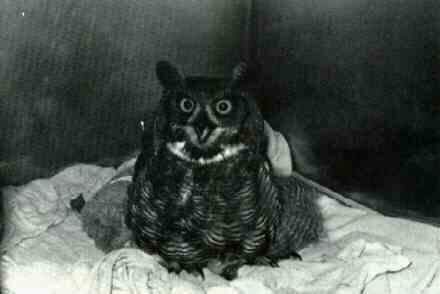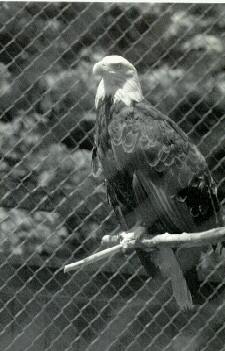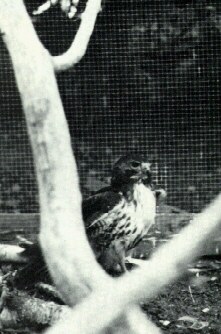
by: J. Shirley Cohrs
SUMMER 1985

Great horned owl recovers at a Dartmouth veterinarians
A bald eagle soaring high over the hills, an osprey crash-diving for smelts in a fast flowing river or a great horned owl ghosting over a woods clearing at dusk, all are beautiful and inspiring sights, uplifting to the soul.
This romantic viewpoint, however, is not shared by all. Until recently our native hawks and owls have been considered vermin to be shot on sight. Although a more enlightened attitude now prevails with the realization that these raptors are often beneficial mousers and scavengers, some are still killed or maimed by gunshot wounds. Destruction of habitat and disturbance of nesting sites, collisions with trains, cars and overhead wires, as well as debilitating or sterilizing accumulations of pesticides and other chemicals continue to threaten their existence.
By their nature, birds of prey tend to be uncommon. They exist at the end of long food chains, mature late and produce few young at a time. With all the new unnatural causes of death, their position could become precarious indeed.
It was with these facts in mind that the Nova Scotia Bird Society began its Raptor Rehabilitation programme in May of 1982. Two members, veterinarians Ian McKay and Jack Cameron, volunteered to treat any birds brought to them at their animal hospital in Dartmouth. Two of their colleagues, Doctors Sandra Simms in Kentville and Hubert Bennett in Lower Sackville, were invited to join the scheme, and accepted.
Having experts to doctor the birds, it was then necessary to find places where the birds could be fed and cared for whilst recovering, as well as being prepared for release back into the wild. Cyril Coldwell in Gaspereau, had been operating such a rehabilitation centre for a number of years and he agreed to be part of the plan. Mike and Elaine Kew, interested in such work through their connection with the Department of Lands and Forests, set up a new centre on their property at Mason's Point, Halifax County.
All these veterinarians and custodians felt strongly enough about the plight of raptors in the Province to donate their knowledge and skills, to say nothing of many hours of their time, to the programme. The money for their expenses (surgical supplies, drugs, caging supplies and equipment) was obtained from the Bird Society's Sanctuary and Scholarship Trust Fund, a registered charity which, up to this time, had invested substantial amounts in the acquisition of land (mostly islands) to preserve nesting bird colonies. Directors of the fund undertook to cover the expenses of the volunteers, plus the cost of transportation of the injured birds to the hospitals and rehabilitation centres.
Now, all systems were go! All that was needed was publicity. Doctors McKay and Cameron sent a letter to every veterinary practice in the province, explaining the scheme and asking their cooperation in emergency treatment and prompt transportation to the designated hospitals. The Department of Lands and Forests approved of the programme and notified all their district offices. Any person finding an injured raptor could take it to the nearest Lands and Forests Depot or the nearest veterinarian and the "system" would take over from there. Press releases were sent to all weekly newspapers in the Province and a representative of the Bird Society spoke on several radio stations.
The hawks and owls began to come in, not so many during the summer but more as fall progressed. Red-tailed hawks, northern harriers (formerly marsh hawks) merlins, kestrels, barred and great horned owls were treated. Some had been caught in leg hold traps, some shot and some hit by cars. Some died, but others lived and after weeks or months of rehabilitation, were restored to the wild.
The programme is not set up to save the lives of raptors so badly damaged that they will never be able to fend for themselves and are condemned to live out their lives as captives. The exception to this is in the case of very rare species, such as hawk owls, boreal owls and great gray owls, which may be used in breeding programmes. Although we do not yet have such a programme in Nova Scotia, birds of this type are sent to the McKeever Owl Rehabilitation Centre in Vineland, Ontario, where they are valuable in helping to restore depleted populations of the species.
The programme is off to a good start and in the three years of its existence dozens of birds have been rehabilitated. The veterinarians and custodians have learned a great deal in this time. The care and rehabilitation of injured raptors is a complex subject and one thing that has been established in rescue work of this kind is that time is of the essence. The kind soul who takes home an injured owl and puts it in a safe warm place for a few days to see how it gets along, seeking help only when it becomes obvious that the bird is not recovering, has probably sentenced it to death. Birds, like people, suffer from shock and infection when injured and it is these two factors which cause more fatalities than the original injuries. The veterinarians treat shock with fluids and drugs and infections with antibiotics, only then turning their attention to the wounds.
The key to success of the programme is public awareness and cooperation, especially that of those people whose work or recreation takes them out of doors and into the countryside. We hope that Nova Scotians will not only accept birds of prey as useful fellow creatures but will take positive steps to help them.
Participating Veterinarians:
- Dr. Ian McKay
- Dr. Jack Cameron
- Dr. Sandra Simms
- Dr. Hubert Bennett
- Dr. David Richardson
- Dr. David Runnalls
- Dr. Susan Humphreys
- DR. J.A. Thompson
 |
 |
The raptor rehabilitation program is not designed to save birds which cannot be returned to the wild. |
Redtailed hawk adjusted well to a missing leg and took live mice quickly. Bird released January 27. |